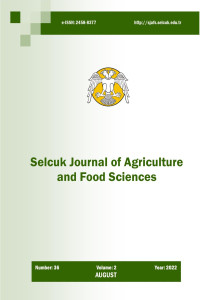Development of Cigarette Beetle [Lasioderma Serricorne (Coleoptera :Anobiidae)] on Spice Plants and Wheat Flour
Abstract
In this study, the development of Lasioderma serricorne (F.) (Coleoptera: Anobiidae) was investigated on five different foods (Mentha piperita, Thymus vulgaris, Salvia officinalis, Rosmarinus, officinalis and flour). Trials were carried out at a temperature of 28±2°C and 70-75% relative humidity. Effects of foods on development adult longevity and egg hatching ratio of Lasioderma serricorne were investigated. As a result, all of the Lasioderma serricorne larvae left on the Rosmarinus officinalis plant have not completed their development and died. The shortest larval development time was in flour (37.35 days) and the longest in Mentha piperita (62.96 days). The shortest Pupal development time was seen in Salvia officinalis (4 days), while the longest was seen in Thymus vulgaris
(4,42 days). Mentha piperita (10,50 days) had the shortest adult longevity and was the longest flour (15,5 days). When the egg development time was examined, it was seen that the shortest time was in Thymus vulgarris (5,42 days) and the longest time was in flour (5,97 days). The rate of larvae that completed its development was highest in flour (92%) and lowest in Salvia officinalis (5%). The rate of pupae that completed its development was highest in flour (80,30%) and lowest in Salvia officinalis (37.50%). In the percentages of hatched eggs, it was observed that the lowest opening was in thyme with 56.27% and the highest opening was in flour with 88.89 %.
Keywords
Cigarette beetle Lasioderma serricorne Mint Thyme Sage Flour
Details
| Primary Language | English |
|---|---|
| Subjects | Botany |
| Journal Section | Research Article |
| Authors | |
| Publication Date | August 25, 2022 |
| Submission Date | December 23, 2021 |
| Published in Issue | Year 2022 Volume: 36 Issue: 2 |
Cite
Selcuk Agricultural and Food Sciences is licensed under a Creative Commons Attribution-NonCommercial 4.0 International License (CC BY NC).


